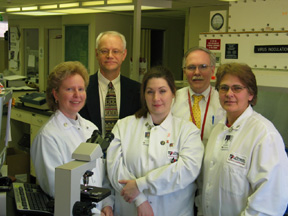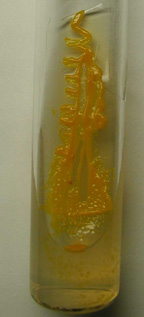 |
Front row, left to right are medical technologists Jeanne Filbey, Amy Petersen and Mary Martins. Back row: Steven Hinrichs, M.D., UNMC professor of pathology and microbiology and director of The Nebraska Medical Center microbiology and virology laboratories and Peter Iwen, Ph.D., associate professor, UNMC pathology and microbiology. Those part of the project not shown are: Stefano Tarantolo, M.D., former UNMC faculty member, now private practice oncologist and Amr Mohamed, Ph.D., former UNMC graduate student, who now holds a faculty position at Assuit University in Egypt. |
Employing molecular diagnostics to solve the mystery, UNMC microbiologists and laboratory specialists at The Nebraska Medical Center accomplished something prestigious in the world of microbiology. They identified a previously unknown organism and named it nebraskense, after the state.
“This may not be equivalent to discovering a new planet, but for biologists, it’s very exciting,” said Steven Hinrichs, M.D., UNMC professor of pathology and microbiology and director of The Nebraska Medical Center microbiology and virology laboratories. “This bacterium wasn’t just created. It’s just that it hasn’t been recognized before. It’s probably been around for a long time.”
The organism, called Mycobacterium nebraskense, is in a family called Mycobacterium, which include diseases like tuberculosis and leprosy. Nebraskense, a new bacterium species commonly found in soil and water, is slow-growing and is known to cause chronic lung infection, including pneumonia. UNMC researchers say it may have a wider range of infection potential.
The UNMC discovery will allow laboratory specialists around the world to identify the organism faster and earlier, enabling health professionals to use the most appropriate treatment. Dr. Hinrichs said treatment is the key because the organism is almost impossible to avoid.
Molecular diagnostics identify organism by their DNA (deoxyribonucleic acid) or RNA (ribonucleic acid), versus growing the organism on a Petri dish, which could take up to six weeks before it’s identified.
 |
Mycobacterium nebraskense in a tube. |
“All the while, your patient and their family doesn’t know what’s wrong. So to speed up the process, we are using molecular approaches to make those diagnoses. We have a significant interest in automation because it can provide more timely diagnosis and treatment, and it can improve patient management.”
UNMC researchers recently published their findings in the International Journal of Systematic and Evolutionary Microbiology. Amr Mohamed, Ph.D., former UNMC graduate student, who now holds a faculty position at Assuit University in Egypt, is first author of the paper. Other authors include Dr. Hinrichs, senior author, and contributing authors Peter Iwen, Ph.D., associate professor, UNMC pathology and microbiology, and Stefano Tarantolo, M.D., a former UNMC faculty member, who is now an Omaha private practice oncologist.
From their work on the project, researchers have patented a molecular diagnostic test kit and are applying for patents on others they’re developing. The kits enable more rapid and accurate ways to diagnose disease. Laboratories performing diagnostic testing for microorganisms, including human and animal, are potential users of the test kits.
“Our capability in virology and molecular diagnostics is probably only exceeded by places like Mayo Clinic, Baylor, and a couple of national laboratories,” Dr. Hinrichs said. “Most labs don’t employ these methods. We’re just beginning to see the vast potential of this technology. It’s faster and more accurate and has the ability to reveal aspects of bacterium such as whether it has antibiotic resistance. It will revolutionize microbiology.”
Scientists say molecular diagnostic technology is a powerful, relatively new tool that has yet to see its full potential in benefiting patients. A wave of new advances being developed will revolutionize the field of diagnostic laboratory tests, making disease diagnosis faster and more accurate.
Gail L. Woods, M.D., professor of pathology at the University of Utah, and a scientist with Associated Regional and University Pathologists, Inc., said the Nebraska discovery uncovered a mystery for her laboratory. “We had the isolate but couldn’t identify it, “Dr. Woods said. “We didn’t know what it was. Once we had the information, we added it to our database. The discovery will allow scientists to learn more about the disease it causes.”
While UNMC researchers say other scientists are making similar strides in the identification of bacteria, what makes the molecular test they’ve developed so effective is that they have found an area in the genetic material of mycobacterium that better identifies these bacteria.
“Within each organism’s DNA, there are ‘signature sequences’ — areas that are unique to the organism,” Dr. Iwen said. “There are multiple signature sequences that can be used for identification purposes. The signatures we have identified are somewhat unique and found to be reliable for identification purposes.
“A test we’ve developed allows us to look at the unique sequence in the genetic material of an organism and identify the species.”
The team also is working on developing the ability to “direct test” patient specimens – making identification available between a matter of hours and a couple of days, instead of taking a month or longer. In addition, scientists also are looking to develop tests to determine resistance of bacteria to certain drugs.
“Health professionals routinely prescribe treatments before they know the organism causing the disease,” Dr. Iwen said. “They don’t always know what’s wrong. Some ask, ‘why worry about obscure organisms that are difficult to identify?’ The answer is because frequently, they require different treatments.”
Dr. Tarantolo, the cancer physician who brought the unusual infection to the attention of UNMC scientists, said the discovery of nebraskense would be of special interest to those treating patients with weak immune systems.
It’s not unusual to see rare, unknown organisms cause disease in cancer patients due to their weakened immune systems, especially at the medical center, where patients have undergone transplantation since 1982.
“It’s always good to identify an organism so you can choose the right treatment options rather than treating patients with multiple antibiotics. In the future, treatments probably can be designed specifically to kill the organism,” Dr. Tarantolo said.